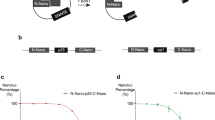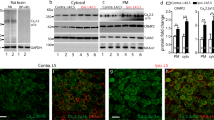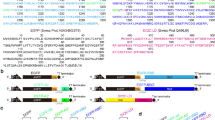Abstract
Fragments of botulinum neurotoxin (BoNT) have been explored as potential targeting moieties and carriers of biomolecules into neurons, although with lower binding and translocation efficiency compared with intact proteins. This study exploits a detoxified recombinant form of full-length BoNT/B (BoTIM/B) fused with core streptavidin (CS-BoTIM/B) for lentiviral targeting to central and autonomic neurons. CS-BoTIM/B underwent an activity-dependent entry into cultured spinal cord neurons. Coupling CS-BoTIM/B to biotinylated lentivirus-encoding green fluorescent protein (GFP) endowed considerable neuron selectivity to the vector as evident from the preferential expression of the reporter in neurons co-cultured with skeletal muscle cells. CS-BoTIM/B-guided lentiviral transduction with the expression of a SNARE protein, SNAP-25 (S25), rendered non-susceptible to proteolysis by three BoNT serotypes, yielded a sizable decrease in cleaved S25 upon exposure of spinal cord neurons to these toxins. This was accompanied by synaptic transmission being spared from blockade by BoNT/A or BoNT/E, reflecting adequate translation and functional competence of recombinant multi-toxin-resistant S25. The augmented neurotropism conveyed on the lentivirus by CS-BoTIM/B was also demonstrated in vivo through enhanced expression of a reporter in intramural ganglionic neurons in the rat trachea, after injection of the targeted GFP-encoding lentivirus. Thus, a novel and realistic prospect for gene therapy of peripheral neuropathies is offered in this study through lentiviral targeting to neurons by CS-BoTIM/B.
This is a preview of subscription content, access via your institution
Access options
Subscribe to this journal
Receive 12 print issues and online access
$259.00 per year
only $21.58 per issue
Buy this article
- Purchase on Springer Link
- Instant access to full article PDF
Prices may be subject to local taxes which are calculated during checkout






Similar content being viewed by others
References
Nanou A, Azzouz M . Gene therapy for neurodegenerative diseases based on lentiviral vectors. Prog Brain Res 2009; 175: 187–200.
Turunen MP, Puhakka HL, Koponen JK, Hiltunen MO, Rutanen J, Leppanen O et al. Peptide-retargeted adenovirus encoding a tissue inhibitor of metalloproteinase-1 decreases restenosis after intravascular gene transfer. Mol Ther 2002; 6: 306–312.
Duval M, Posner MR, Cavacini LA . A bispecific antibody composed of a nonneutralizing antibody to the gp41 immunodominant region and an anti-CD89 antibody directs broad human immunodeficiency virus destruction by neutrophils. J Virol 2008; 82: 4671–4674.
Kang Y, Stein CS, Heth JA, Sinn PL, Penisten AK, Staber PD et al. In vivo gene transfer using a nonprimate lentiviral vector pseudotyped with Ross River Virus glycoproteins. J Virol 2002; 76: 9378–9388.
Federici T, Kutner R, Zhang XY, Kuroda H, Tordo N, Boulis NM et al. Comparative analysis of HIV-1-based lentiviral vectors bearing lyssavirus glycoproteins for neuronal gene transfer. Genet Vaccines Ther 2009; 7: 1.
Schiavo G, Matteoli M, Montecucco C . Neurotoxins affecting neuroexocytosis. Physiol Rev 2000; 80: 717–766.
Dolly JO, Lawrence GW, Meng J, Wang J, Ovsepian SV . Neuro-exocytosis: botulinum toxins as inhibitory probes and versatile therapeutics. Curr Opin Pharmacol 2009; 9: 326–335.
Johnson EA, Bradshaw M . Clostridium botulinum and its neurotoxins: a metabolic and cellular perspective. Toxicon 2001; 39: 1703–1722.
Andreu A, Fairweather N, Miller AD . Clostridium neurotoxin fragments as potential targeting moieties for liposomal gene delivery to the CNS. Chembiochem 2008; 9: 219–231.
Schneider H, Groves M, Muhle C, Reynolds PN, Knight A, Themis M et al. Retargeting of adenoviral vectors to neurons using the Hc fragment of tetanus toxin. Gene Therapy 2000; 7: 1584–1592.
Zhang P, Ray R, Singh BR, Li D, Adler M, Ray P . An efficient drug delivery vehicle for botulism countermeasure. BMC Pharmacol 2009; 9: 12.
Fishman PS . Tetanus Toxin. Saunders Elsevier: Philadelphia, PA, 2009.
Weller U, Taylor CF, Habermann E . Quantitative comparison between tetanus toxin, some fragments and toxoid for binding and axonal transport in the rat. Toxicon 1986; 24: 1055–1063.
Li Y, Foran P, Lawrence G, Mohammed N, Chan-Kwo-Chion CK, Lisk G et al. Recombinant forms of tetanus toxin engineered for examining and exploiting neuronal trafficking pathways. J Biol Chem 2001; 276: 31394–31401.
Deinhardt K, Schiavo G . Endocytosis and retrograde axonal traffic in motor neurons. Biochem Soc Symp 2005; 72: 139–150.
Schwab ME, Thoenen H . Electron microscopic evidence for a transsynaptic migration of tetanus toxin in spinal cord motoneurons: an autoradiographic and morphometric study. Brain Res 1976; 105: 213–227.
Simpson LL . Identification of the characteristics that underlie botulinum toxin potency: implications for designing novel drugs. Biochimie 2000; 82: 943–953.
Larsen JC . U.S. Army Botulinum Neurotoxin (BoNT) Medical Therapeutics Research Program: Past Accomplishments and Future Directions.. Drug Dev Res 2009; 70: 266–278.
Montal M . Translocation of botulinum neurotoxin light chain protease by the heavy chain protein-conducting channel. Toxicon 2009; 54: 565–569.
Goodnough MC, Oyler G, Fishman PS, Johnson EA, Neale EA, Keller JE et al. Development of a delivery vehicle for intracellular transport of botulinum neurotoxin antagonists. FEBS Lett 2002; 513: 163–168.
Bade S, Rummel A, Reisinger C, Karnath T, Ahnert-Hilger G, Bigalke H et al. Botulinum neurotoxin type D enables cytosolic delivery of enzymatically active cargo proteins to neurones via unfolded translocation intermediates. J Neurochem 2004; 91: 1461–1472.
Binz T, Rummel A . Cell entry strategy of clostridial neurotoxins. J Neurochem 2009; 109: 1584–1595.
Montal M . Botulinum neurotoxin: a marvel of protein design. Annu Rev Biochem 2010; 79: 591–617.
Nishiki T, Tokuyama Y, Kamata Y, Nemoto Y, Yoshida A, Sato K et al. The high-affinity binding of Clostridium botulinum type B neurotoxin to synaptotagmin II associated with gangliosides GT1b/GD1a. FEBS Lett 1996; 378: 253–257.
Takamori S, Holt M, Stenius K, Lemke EA, Gronborg M, Riedel D et al. Molecular anatomy of a trafficking organelle. Cell 2006; 127: 831–846.
Black JD, Dolly JO . Interaction of 125I-labeled botulinum neurotoxins with nerve terminals. I. Ultrastructural autoradiographic localization and quantitation of distinct membrane acceptors for types A and B on motor nerves. J Cell Biol 1986; 103: 521–534.
Schiavo G, Rossetto O, Santucci A, DasGupta BR, Montecucco C . Botulinum neurotoxins are zinc proteins. J Biol Chem 1992; 267: 23479–23483.
Coen L, Osta R, Maury M, Brulet P . Construction of hybrid proteins that migrate retrogradely and transynaptically into the central nervous system. Proc Natl Acad Sci USA 1997; 94: 9400–9405.
O'Sullivan GA, Mohammed N, Foran PG, Lawrence GW, Oliver Dolly J . Rescue of exocytosis in botulinum toxin A-poisoned chromaffin cells by expression of cleavage-resistant SNAP-25. Identification of the minimal essential C-terminal residues. J Biol Chem 1999; 274: 36897–36904.
Koticha DK, McCarthy EE, Baldini G . Plasma membrane targeting of SNAP-25 increases its local concentration and is necessary for SNARE complex formation and regulated exocytosis. J Cell Sci 2002; 115: 3341–3351.
Kuder T, Szczurkowski A, Kuchinka J, Nowak E . The AChE-positive ganglia in the trachea and bronchi of the cat. Folia Morphol (Warsz) 2003; 62: 99–106.
Kusindarta DL, Atoji Y, Yamamoto Y . Nerve plexuses in the trachea and extrapulmonary bronchi of the rat. Arch Histol Cytol 2004; 67: 41–55.
Dong M, Richards DA, Goodnough MC, Tepp WH, Johnson EA, Chapman ER . Synaptotagmins I and II mediate entry of botulinum neurotoxin B into cells. J Cell Biol 2003; 162: 1293–1303.
Sano T, Pandori MW, Chen X, Smith CL, Cantor CR . Recombinant core streptavidins. A minimum-sized core streptavidin has enhanced structural stability and higher accessibility to biotinylated macromolecules. J Biol Chem 1995; 270: 28204–28209.
Mastromarino P, Conti C, Goldoni P, Hauttecoeur B, Orsi N . Characterization of membrane components of the erythrocyte involved in vesicular stomatitis virus attachment and fusion at acidic pH. J Gen Virol 1987; 68 (Part 9): 2359–2369.
Ghadge GD, Roos RP, Kang UJ, Wollmann R, Fishman PS, Kalynych AM et al. CNS gene delivery by retrograde transport of recombinant replication-defective adenoviruses. Gene Therapy 1995; 2: 132–137.
Wood MJ, Byrnes AP, Kaplitt MG, Pfaff DW, Rabkin SD, Charlton HM . Specific patterns of defective HSV-1 gene transfer in the adult central nervous system: implications for gene targeting. Exp Neurol 1994; 130: 127–140.
Lilley CE, Groutsi F, Han Z, Palmer JA, Anderson PN, Latchman DS et al. Multiple immediate-early gene-deficient herpes simplex virus vectors allowing efficient gene delivery to neurons in culture and widespread gene delivery to the central nervous system in vivo. J Virol 2001; 75: 4343–4356.
Davidson BL, Breakefield XO . Viral vectors for gene delivery to the nervous system. Nat Rev Neurosci 2003; 4: 353–364.
Washbourne P, Bortoletto N, Graham ME, Wilson MC, Burgoyne RD, Montecucco C . Botulinum neurotoxin E-insensitive mutants of SNAP-25 fail to bind VAMP but support exocytosis. J Neurochem 1999; 73: 2424–2433.
Raghunath A, Perez-Branguli F, Smith L, Dolly JO . Adeno-associated virus transfer of a gene encoding SNAP-25 resistant to botulinum toxin A attenuates neuromuscular paralysis associated with botulism. J Neurosci 2008; 28: 3683–3688.
Cherington M . Clinical spectrum of botulism. Muscle Nerve 1998; 21: 701–710.
Hayashi T, McMahon H, Yamasaki S, Binz T, Hata Y, Sudhof TC et al. Synaptic vesicle membrane fusion complex: action of clostridial neurotoxins on assembly. EMBO J 1994; 13: 5051–5061.
Pellegrini LL, O'Connor V, Lottspeich F, Betz H . Clostridial neurotoxins compromise the stability of a low energy SNARE complex mediating NSF activation of synaptic vesicle fusion. EMBO J 1995; 14: 4705–4713.
Meng J, Ovsepian SV, Wang J, Pickering M, Sasse A, Aoki KR et al. Activation of TRPV1 mediates calcitonin gene-related peptide release, which excites trigeminal sensory neurons and is attenuated by a retargeted botulinum toxin with anti-nociceptive potential. J Neurosci 2009; 29: 4981–4992.
Huang X, Wheeler MB, Kang YH, Sheu L, Lukacs GL, Trimble WS et al. Truncated SNAP-25 (1–197), like botulinum neurotoxin A, can inhibit insulin secretion from HIT-T15 insulinoma cells. Mol Endocrinol 1998; 12: 1060–1070.
Lawrence GW, Foran P, Mohammed N, DasGupta BR, Dolly JO . Importance of two adjacent C-terminal sequences of SNAP-25 in exocytosis from intact and permeabilized chromaffin cells revealed by inhibition with botulinum neurotoxins A and E. Biochemistry 1997; 36: 3061–3067.
Foran P, Lawrence GW, Shone CC, Foster KA, Dolly JO . Botulinum neurotoxin C1 cleaves both syntaxin and SNAP-25 in intact and permeabilized chromaffin cells: correlation with its blockade of catecholamine release. Biochemistry 1996; 35: 2630–2636.
Williamson LC, Halpern JL, Montecucco C, Brown JE, Neale EA . Clostridial neurotoxins and substrate proteolysis in intact neurons: botulinum neurotoxin C acts on synaptosomal-associated protein of 25 kDa. J Biol Chem 1996; 271: 7694–7699.
Gonzalo S, Linder ME . SNAP-25 palmitoylation and plasma membrane targeting require a functional secretory pathway. Mol Biol Cell 1998; 9: 585–597.
Washbourne P, Cansino V, Mathews JR, Graham M, Burgoyne RD, Wilson MC . Cysteine residues of SNAP-25 are required for SNARE disassembly and exocytosis, but not for membrane targeting. Biochem J 2001; 357: 625–634.
Naumann M, Jost WH, Toyka KV . Botulinum toxin in the treatment of neurological disorders of the autonomic nervous system. Arch Neurol 1999; 56: 914–916.
Sano T, Cantor CR . Cooperative biotin binding by streptavidin. Electrophoretic behavior and subunit association of streptavidin in the presence of 6M urea. J Biol Chem 1990; 265: 3369–3373.
Pahler A, Hendrickson WA, Kolks MA, Argarana CE, Cantor CR . Characterization and crystallization of core streptavidin. J Biol Chem 1987; 262: 13933–13937.
Wang J, Zurawski TH, Meng J, Lawrence G, Olango WM, Finn DP et al. A Di-leucine in the protease of botulinum toxin A underlies its long-lived neuroparalysis: transfer of longevity to a novel potential therapeutic. J Biol Chem 2010 [e-pub ahead of print 7 December 2010]. PMID: 21138836.
Boussif O, Lezoualc'h F, Zanta MA, Mergny MD, Scherman D, Demeneix B et al. A versatile vector for gene and oligonucleotide transfer into cells in culture and in vivo: polyethylenimine. Proc Natl Acad Sci USA 1995; 92: 7297–7301.
Moore JP, McKeating JA, Weiss RA, Sattentau QJ . Dissociation of gp120 from HIV-1 virions induced by soluble CD4. Science 1990; 250: 1139–1142.
Green NM, Toms EJ . Purification and crystallization of avidin. Biochem J 1970; 118: 67–70.
Cordingley MG, Callahan PL, Sardana VV, Garsky VM, Colonno RJ . Substrate requirements of human rhinovirus 3C protease for peptide cleavage in vitro. J Biol Chem 1990; 265: 9062–9065.
Anderson KN, Potter AC, Piccenna LG, Quah AK, Davies KE, Cheema SS . Isolation and culture of motor neurons from the newborn mouse spinal cord. Brain Res Brain Res Protoc 2004; 12: 132–136.
Ovsepian SV, Friel DD . The leaner P/Q-type calcium channel mutation renders cerebellar Purkinje neurons hyper-excitable and eliminates Ca2+-Na+ spike bursts. Eur J Neurosci 2008; 27: 93–103.
Acknowledgements
This study is supported by USAMRIID (grant number HDTRA1-07-C-0034) and a Research Professorship plus Principal Investigator award (to JOD) from the Science Foundation Ireland. We are grateful to Dr Jiafu Wang for providing the pET-29a clone of BoNT/B and Liam Ryan for technical assistance.
Author information
Authors and Affiliations
Corresponding author
Ethics declarations
Competing interests
The authors declare no conflict of interest.
Additional information
Supplementary Information accompanies the paper on Gene Therapy website
Rights and permissions
About this article
Cite this article
O'Leary, V., Ovsepian, S., Raghunath, A. et al. Innocuous full-length botulinum neurotoxin targets and promotes the expression of lentiviral vectors in central and autonomic neurons. Gene Ther 18, 656–665 (2011). https://doi.org/10.1038/gt.2011.8
Received:
Revised:
Accepted:
Published:
Issue Date:
DOI: https://doi.org/10.1038/gt.2011.8
Keywords
This article is cited by
-
Neurotoxin-Derived Optical Probes for Biological and Medical Imaging
Molecular Imaging and Biology (2023)
-
Tuberous Sclerosis (tsc2+/-) Model Eker Rats Reveals Extensive Neuronal Loss with Microglial Invasion and Vascular Remodeling Related to Brain Neoplasia
Neurotherapeutics (2020)
-
Alleviation of Trigeminal Nociception Using p75 Neurotrophin Receptor Targeted Lentiviral Interference Therapy
Neurotherapeutics (2018)
-
PARTICLE triplexes cluster in the tumor suppressor WWOX and may extend throughout the human genome
Scientific Reports (2017)
-
Low-Affinity Neurotrophin Receptor p75 Promotes the Transduction of Targeted Lentiviral Vectors to Cholinergic Neurons of Rat Basal Forebrain
Neurotherapeutics (2016)



